Coordinates: 38°52′59″N 77°0′59″W / 38.88306°N 77.01639°W
| National Aeronautics and Space Administration | |
|---|---|
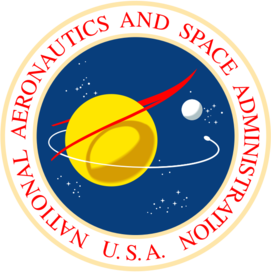 | |
| NASA seal | |
 | |
| NASA insignia Motto: For the Benefit of All[1] | |
| Agency overview | |
| Formed | July 29, 1958 |
| Preceding agency | NACA |
| Jurisdiction | United States government |
| Headquarters | Washington, D.C. 38°52′59″N 77°0′59″W / 38.88306°N 77.01639°W |
| Employees | 17,900[2] |
| Annual budget | US$17.6 billion (FY 2009)[3] See also NASA Budget |
| Agency executives | Charles Bolden, administrator Lori Garver, deputy administrator |
| Website | |
| www.nasa.gov | |
The National Aeronautics and Space Administration (NASA, pronounced /ˈnæsə/) is an Executive Branch agency of the United States government, responsible for the nation's civilian space program and aeronautics and aerospace research. Since February 2006, NASA's self-described mission statement is to "pioneer the future in space exploration, scientific discovery and aeronautics research."[4]
NASA was established by the National Aeronautics and Space Act on July 29, 1958, replacing its predecessor, the National Advisory Committee for Aeronautics (NACA). The agency became operational on October 1, 1958.[5][6] NASA has led U.S. efforts for space exploration since, including the Apollo moon-landing missions, the Skylab space station, and later the Space Shuttle. Currently, NASA is supporting the International Space Station and has been developing the manned Orion spacecraft.
NASA science is focused on better understanding Earth through the Earth Observing System,[7] advancing heliophysics through the efforts of the Science Mission Directorate's Heliophysics Research Program,[8] exploring bodies throughout the Solar System with advanced robotic missions such as New Horizons,[9] and researching astrophysics topics, such as the Big Bang, through the Great Observatories and associated programs.[10] NASA shares data with various national and international organizations such as from the Greenhouse Gases Observing Satellite.
History
Space race
NACA
On January 14, 1958, NACA Director Hugh Dryden published "A National Research Program for Space Technology" stating:[11]
| " | It is of great urgency and importance to our country both from consideration of our prestige as a nation as well as military necessity that this challenge [Sputnik] be met by an energetic program of research and development for the conquest of space... It is accordingly proposed that the scientific research be the responsibility of a national civilian agency... NACA is capable, by rapid extension and expansion of its effort, of providing leadership in space technology. | " |
Launched on January 31, 1958, Explorer 1, officially Satellite 1958 Alpha, became the U.S.'s first earth satellite.[12] The Explorer 1 payload consisted of the Iowa Cosmic Ray Instrument without a tape data recorder which was not modified in time to make it onto the satellite.
On March 5, PSAC Chairman James Killian wrote a memorandum to President Eisenhower, entitled "Organization for Civil Space Programs", encouraging the creation of a civil space program based upon a "strengthened and redesignated" NACA which could expand its research program "with a minimum of delay."[11] In late March, a NACA report entitled "Suggestions for a Space Program" included recommendations for subsequently developing a hydrogen fluorine fueled rocket of 4,450,000 newtons (1,000,000 lbf) thrust designed with second and third stages.[6]
In April 1958, Eisenhower delivered to the U.S. Congress an executive address favoring a national civilian space agency and submitted a bill to create a "National Aeronautical and Space Agency."[6] NACA's former role of research alone would change to include large-scale development, management, and operations.[6] The U.S. Congress passed the bill, somewhat reworded, as the National Aeronautics and Space Act of 1958, on July 16.[6] Only two days later von Braun's Working Group submitted a preliminary report severely criticizing the duplication of efforts and lack of coordination among various organizations assigned to the United States' space programs.[6] Stever's Committee on Space Technology concurred with the criticisms of the von Braun Group (a final draft was published several months later, in October).[6]
NASA

On July 29, 1958, Eisenhower signed the National Aeronautics and Space Act, establishing NASA. When it began operations on October 1, 1958, NASA absorbed the 46-year-old NACA intact; its 8,000 employees, an annual budget of US$100 million, three major research laboratories (Langley Aeronautical Laboratory, Ames Aeronautical Laboratory, and Lewis Flight Propulsion Laboratory) and two small test facilities.[13]
Elements of the Army Ballistic Missile Agency, of which von Braun's team was a part, and the Naval Research Laboratory were incorporated into NASA. A significant contributor to NASA's entry into the Space Race with the Soviet Union was the technology from the German rocket program (led by von Braun) which in turn incorporated the technology of Robert Goddard's earlier works.[14] Earlier research efforts within the U.S. Air Force[13] and many of ARPA's early space programs were also transferred to NASA.[15] In December 1958, NASA gained control of the Jet Propulsion Laboratory, a contractor facility operated by the California Institute of Technology.[13]
NASA programs
Project Mercury

Project Gemini
Apollo program
The Apollo program landed the first humans on Earth's Moon. Apollo 11 landed on the moon on July 20, 1969 with astronauts Neil Armstrong and Buzz Aldrin, while Michael Collins orbited above. Five subsequent Apollo missions also landed astronauts on the Moon, the last in December 1972. In these six Apollo spaceflights twelve men walked on the Moon. These missions returned a wealth of scientific data and 381.7 kilograms (842 lb) of lunar samples. Experiments included soil mechanics, meteoroids, seismic, heat flow, lunar ranging, magnetic fields, and solar wind experiments.
Apollo set major milestones in human spaceflight. It stands alone in sending manned missions beyond low Earth orbit, and landing humans on another celestial body.[22] Apollo 8 was the first manned spacecraft to orbit another celestial body, while Apollo 17 marked the last moonwalk and the last manned mission beyond low Earth orbit. The program spurred advances in many areas of technology peripheral to rocketry and manned spaceflight, including avionics, telecommunications, and computers. Apollo sparked interest in many fields of engineering and left many physical facilities and machines developed for the program as landmarks. Many objects and artifacts from the program are on display at various locations throughout the world, notably at the Smithsonian's Air and Space Museums.
Skylab
ASTP
Space Shuttle program

In 1995 Russian-American interaction resumed with the Shuttle-Mir missions. Once more an American vehicle docked with a Russian craft, this time a full-fledged space station. This cooperation continues to today, with Russia and America the two biggest partners in the largest space station ever built: the International Space Station (ISS). The strength of their cooperation on this project was even more evident when NASA began relying on Russian launch vehicles to service the ISS during the two-year grounding of the shuttle fleet following the 2003 Space Shuttle Columbia disaster.
The shuttle fleet lost two orbiters and 14 astronauts in two disasters: Challenger in 1986, and Columbia in 2003.[27] While the 1986 loss was mitigated by building the Space Shuttle Endeavour from replacement parts, NASA did not build another orbiter to replace the second loss.[27] NASA's shuttle program has made 132 successful launches as of May 2010.
International Space Station
The ISS is operated as a joint project among NASA, the Russian Federal Space Agency, the Japan Aerospace Exploration Agency, the Canadian Space Agency, and the European Space Agency (ESA). Ownership and utilization of the space station is set out via several intergovernmental treaties and agreements, with the Russian Federation retaining full ownership of its own modules, and the rest of the station being allocated among the other international partners. The International Space Station relied on the Shuttle fleet for all major construction shipments.
The cost of the station project has been estimated by ESA as €100 billion over a course of 30 years, although cost estimates vary between 35 billion dollars and 160 billion dollars, making the ISS the most expensive object ever constructed.
Unmanned programs
Of the ten vehicles in the Mariner series, seven were successful and three were lost. The planned Mariner 11 and Mariner 12 vehicles evolved into Voyager 1 and Voyager 2 of the Voyager program, while the Viking 1 and Viking 2 Mars orbiters were enlarged versions of the Mariner 9 spacecraft. Other Mariner-based spacecraft, launched since Voyager, included the Magellan probe to Venus, and the Galileo probe to Jupiter. A second-generation Mariner spacecraft, called the Mariner Mark II series, eventually evolved into the Cassini-Huygens probe, now in orbit around Saturn.
All Mariner spacecraft were based on a hexagonal or octagonal "bus", which housed all of the electronics, and to which all components were attached, such as antennae, cameras, propulsion, and power sources. All probes except Mariner 1, Mariner 2 and Mariner 5 had TV cameras. The first five Mariners were launched on Atlas-Agena rockets, while the last five used the Atlas-Centaur. All Mariner-based probes after Mariner 10 used the Titan IIIE, Titan IV unmanned rockets or the Space Shuttle with a solid-fueled Inertial Upper Stage and multiple planetary flybys.
Pioneer program
Additionally, the Pioneer mission to Venus consisted of two components, launched separately. Pioneer Venus 1 or Pioneer Venus Orbiter was launched in 1978 and studied the planet for more than a decade after orbital insertion in 1978. Pioneer Venus 2 or Pioneer Venus Multiprobe sent four small probes into the Venusian atmosphere.
Voyager program
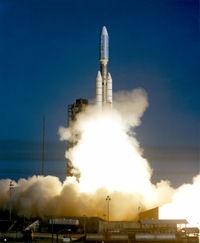
As of November 12, 2010, Voyager 1 was at a distance of 115.251 AU (17.242 billion km, or 10.712 billion miles), traveling away from both the Earth and the Sun at a speed of 17 kilometres (11 mi)/s, which corresponds to a greater specific orbital energy than any other probe.[29]
Viking program
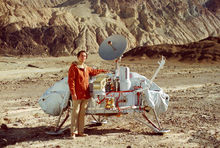
The primary objectives of the Viking orbiters were to transport the landers to Mars, perform reconnaissance to locate and certify landing sites, act as a communications relays for the landers, and to perform their own scientific investigations. The orbiter, based on the earlier Mariner 9 spacecraft, was an octagon approximately 2.5 m across. The total launch mass was 2,328 kilograms (5,130 lb), of which 1,445 kilograms (3,190 lb) were propellant and attitude control gas.
Helios probes
Hubble Space Telescope
The HST was created with a relatively small budget of $2 billion[31] and has continued operation since 1990, delighting both scientists and the public. Some of its images, such as the groundbreaking Hubble Deep Field, have become famous.
Magellan probe
Magellan created the first (and currently the best) high resolution mapping of the planet's surface features. Prior Venus missions had created low resolution radar globes of general, continent-sized formations. Magellan, performed detailed imaging and analysis of craters, hills, ridges, and other geologic formations, to a degree comparable to the visible-light photographic mapping of other planets.
Galileo probe
Despite antenna problems, Galileo conducted the first asteroid flyby, discovered the first asteroid moon, was the first spacecraft to orbit Jupiter, and launched the first probe into Jupiter's atmosphere. Galileo's prime mission was a two-year study of the Jovian system. The spacecraft traveled around Jupiter in elongated ellipses, each orbit lasting about two months. The differing distances from Jupiter afforded by these orbits allowed Galileo to sample different parts of the planet's extensive magnetosphere. The orbits were designed for close up flybys of Jupiter's largest moons. Once Galileo's prime mission was concluded, an extended mission followed starting on December 7, 1997; the spacecraft made a number of daring close flybys of Jupiter's moons Europa and Io. The closest approach was 180 kilometres (110 mi) (112 mi) on October 15, 2001.
On September 21, 2003, after 14 years in space and eight years of service in the Jovian system, Galileo′s mission was terminated by sending the orbiter into Jupiter's atmosphere at a speed of nearly 50 kilometers per second to avoid any chance of it contaminating local moons with bacteria from Earth. Of particular interest was the ice-crusted moon Europa, which, thanks to Galileo, scientists now suspect harbors a salt water ocean beneath its surface.
Mars Global Surveyor
The Surveyor spacecraft used a series of high-resolution cameras to explore the surface of Mars during its mission, returning more than 240,000 images spanning portions of 4.8 Martian years, from September 1997 to November 2006.[32] The surveyor's cameras utilized 3 instruments: a narrow angle camera that took (black-and-white) high resolution images (usually 1.5 to 12 m per pixel) red and blue wide angle pictures for context (240 m per pixel) and daily global imaging (7.5 kilometres (4.7 mi) per pixel).[33]
Mars Pathfinder
This mission, besides being the first of a series of missions to Mars that included rovers (robotic exploration vehicles), was the most important since the Vikings landed on the red planet in 1976, and also was the first successful mission to send a rover to a planet. In addition to scientific objectives, the Mars Pathfinder mission was also a "proof-of-concept" for various technologies, such as airbag-mediated touchdown and automated obstacle avoidance, both later exploited by the Mars Exploration Rovers. The Mars Pathfinder was also remarkable for its extremely low price relative to other unmanned space missions to Mars.
Mars Exploration Rovers
The mission began in 2003 with the sending of the two rovers — MER-A Spirit and MER-B Opportunity — to explore the Martian surface and geology. The mission's scientific objective is to search for and characterize a wide range of rocks and soils that hold clues to past water activity on Mars. The mission is part of NASA's Mars Exploration Program which includes three previous successful landers: the two Viking program landers in 1976 and Mars Pathfinder probe in 1997.[35]
The total cost of building, launching, landing and operating the rovers on the surface for the initial 90-Martian-day (sol) primary mission was US$820 million.[36] Since the rovers have continued to function far beyond their initial 90 sol primary mission (to date both rovers have been functioning on Mars's surface for nearly seven years), they have each received multiple mission extensions.
In recognition of the vast amount of scientific information amassed by both rovers, two asteroids have been named in their honor: 37452 Spirit and 39382 Opportunity.
New Horizons probe
New Horizons was launched on January 19, 2006 directly into an Earth-and-solar-escape trajectory. It had an Earth-relative velocity of about 16.26 kilometres (10.10 mi)/s or 58,536 kilometres (36,373 mi)/h (10.10 mi/s or 36,373 mi/h) after its last engine shut down. Thus, it left Earth at the fastest launch speed ever recorded for a man-made object (although its specific orbital energy is less than that of Voyager 1, and the Helios Probes retain the maximum speed record for a spacecraft). New Horizons flew by Jupiter on February 28, 2007 and Saturn's orbit on June 8, 2008. It will arrive at Pluto on July 14, 2015 and then continue into the Kuiper belt.
NASA's future
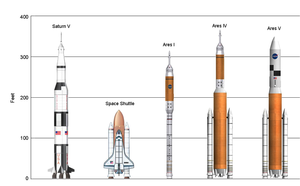
During much of the 1990s, NASA was faced with shrinking annual budgets due to congressional belt-tightening. In response, NASA's ninth administrator, Daniel Goldin, pioneered the "faster, better, cheaper" approach that enabled NASA to cut costs while still delivering a wide variety of aerospace programs (Discovery Program). That method was criticized and re-evaluated following the twin losses of Mars Climate Orbiter and Mars Polar Lander in 1999.
It is the current space policy of the United States that NASA, "execute a sustained and affordable human and robotic program of space exploration and develop, acquire, and use civil space systems to advance fundamental scientific knowledge of our Earth system, solar system, and universe."[37] NASA's ongoing investigations include in-depth surveys of Mars and Saturn and studies of the Earth and the Sun. Other NASA spacecraft are presently en route to Mercury, Pluto and the asteroid belt. With missions to Jupiter in planning stages, NASA's itinerary covers over half the solar system.
An improved and larger planetary rover, Mars Science Laboratory, is under construction and slated to launch in 2011, after a slight delay caused by hardware challenges, which has bumped it back from the October 2009 scheduled launch.[38] The New Horizons mission to Pluto was launched in 2006 and will fly by Pluto in 2015. The probe received a gravity assist from Jupiter in February 2007, examining some of Jupiter's inner moons and testing on-board instruments during the fly-by. On the horizon of NASA's plans is the MAVEN spacecraft as part of the Mars Scout Program to study the atmosphere of Mars.[39]
Vision for Space Exploration
Hoping to spur innovation from the private sector, NASA established a series of Centennial Challenges, technology prizes for non-government teams, in 2004. The Challenges include tasks that will be useful for implementing the Vision for Space Exploration, such as building more efficient astronaut gloves.[42] In February 2010, NASA announced that it would be awarding $50 million in contracts to commercial spaceflight companies including Blue Origin, Boeing, Paragon Space Development Corporation, Sierra Nevada Corporation and United Launch Alliance to design and develop viable reusable launch vehicles.[43]
Moon base
On December 4, 2006, NASA announced it was planning a permanent moon base.[44] NASA Associate Administrator Scott Horowitz said the goal was to start building the moonbase by 2020, and by 2024, have a fully functional base that would allow for crew rotations and in-situ resource utilization. Additionally, NASA plans to collaborate and partner with other nations for this project. As of February 1, 2010, however, President Obama has scrapped the possibility of a moon base through his budget as he believes that NASA should be more focused on deep space missions.
Human exploration of Mars
On September 28, 2007 Michael D. Griffin, who was at the time Administrator of NASA, stated that NASA aims to put a man on Mars by 2037.
Alan Stern, NASA's "hard-charging" and "reform-minded"[47] associate administrator for the Science Mission Directorate, resigned on March 25, 2008,[48] effective April 11, 2008, after he allegedly ordered funding cuts to the Mars Exploration Rover (MER) and Mars Odyssey that were overturned by NASA Administrator Michael D. Griffin. The cuts were intended to offset cost overruns for the Mars Science Laboratory. Stern has stated that he "did not quit over MER" and that he "wasn't the person who tried to cut MER".[49] Stern, who served for nearly a year and has been credited with making "significant changes that have helped restore the importance of science in NASA's mission",[50][51] says he left to avoid cutting healthy programs and basic research in favor of politically sensitive projects. Griffin favored cutting "less popular parts" of the budget, including basic research, and Stern's refusal to do so led to his resignation.[52]
Recent developments
The Office of Science and Technology Policy (OSTP) established the Augustine Commission to ensure the nation is on "a vigorous and sustainable path to achieving its boldest aspirations in space."[53] on May 7, 2009.
In its October 22, 2009 report, the Commission proposed three basic options for exploration beyond low Earth orbit:
- Mars First, with a Mars landing, perhaps after a brief test of equipment and procedures on the Moon.
- Moon First, with lunar surface exploration focused on developing the capability to explore Mars.
- A Flexible Path to inner solar system locations, such as lunar orbit, Lagrange points, near-Earth objects and the moons of Mars, followed by exploration of the lunar surface and/or Martian surface.
President Barack Obama announced changes to NASA space policy, in his April 15, 2010 space policy speech at Kennedy Space Center, from the Moon-first approach adopted previously under the Vision for Space Exploration and Constellation program to a variety of destinations resembling the flexible path approach.
The new plan calls for NASA to extend the life of the ISS by 5 years and use launch vehicles designed, manufactured, and operated by private aerospace companies with NASA paying for flights for government astronauts to the ISS and LEO, much like the way private space tourism company Space Adventures bought Soyuz flights from the Russian government for space tourists.
Boeing and Lockheed Martin have expressed doubts about the new plan,[54] while other aerospace companies, including SpaceX, have strongly endorsed it.
NASA's selected SpaceX and Orbital Sciences for its Commercial Orbital Transportation Services (COTS) program. The first launch of SpaceX's Falcon 9 occurred on December 8, 2010;[55] it was the unmanned first spaceflight of the SpaceX Dragon spacecraft, which orbited the Earth. It was the first demonstration flight for the COTS program.
Mission statement and vision
- To improve life here, to extend life to there, to find life beyond.[56] — Mission Statement
- NASA's mission is to pioneer the future in space exploration, scientific discovery and aeronautics research.[57] — Mission
- To understand and protect our home planet, to explore the Universe and search for life, and to inspire the next generation of explorers... as only NASA can.[56] — NASA Vision
Controversy
The chair and ranking member of the U.S. Senate Committee on Homeland Security and Governmental Affairs wrote NASA Administrator Griffin on July 31, 2006 expressing concerns about the change.[58] NASA also canceled or delayed a number of earth science missions in 2006.[59]
In 2009, NASA announced that the agency plans to provide $1.75 million in funding to Jack Bergman of Harvard's McLean Hospital to conduct an experiment on monkeys to determine the health effects of radiation exposure during travel in deep space.[60] The plan has faced opposition from animal rights groups such as PETA and HSUS, a physicians' group PCRM, and several federal legislators lead by Representative Jim Moran of Virginia[61] who claim that the grant should be cancelled because during the course of the experiment, the primates will likely contract malignant tumors as well as blindness, skin damage, cognitive decline, premature aging and death. PCRM also claims that the proposed use and isolation of primates would violate NASA's stated principles regarding animal ethics.[62][63] The group has filed a federal complaint alleging that the experiments would also violate the Animal Welfare Act.[64]
Public perception of the NASA budget is very different from reality and has been the subject of controversy since the agency's creation. A 1997 poll reported that Americans had an average estimate of 20% for NASA's share of the federal budget. In reality, NASA's budget has been between 0.5% and 1% from the late 1960s on. NASA budget briefly peaked at over 4% of the federal budget in the mid-1960s during the build up to the Apollo program.[65]
Leadership
Other leadership positions within NASA include:
- Office of the Administrator
- Associate Administrator (currently Christopher Scolese)
- Chief of Staff (currently David Radzanowski)
- Advisory Groups
- NASA Advisory Council (NAC)
- Chairman: Dr. Kenneth Ford
- Aerospace Safety Advisory Panel (ASAP)
- Chairman: Vice Admiral Joe Dyer USN, (Ret.)
- NASA Advisory Council (NAC)
- Office of the Inspector General
- Inspector General: Paul K. Martin
Facilities
NASA Headquarters in Washington, DC provides overall guidance and direction to the agency.[69] NASA's Shared Services center is located on the grounds of the John C. Stennis Space Center, near Bay St. Louis, Mississippi.[70] Construction of the Shared Services facility began in August 2006 and it was completed in June 2008.[70] NASA operates a short-line railroad at the Kennedy Space Center. Various field and research installations are listed below by application. Some facilities serve more than one application for historic or administrative reasons.
Research centers
- Ames Research Center, Moffett Federal Airfield, Mountain View, California
- Jet Propulsion Laboratory, California Institute of Technology, Pasadena, California
- Goddard Institute for Space Studies, New York City
- Goddard Space Flight Center, Greenbelt, Maryland
- John H. Glenn Research Center at Lewis Field, Cleveland, Ohio
- Langley Research Center, Hampton, Virginia
Test facilities
- Glenn Research Center, Plum Brook Station, Sandusky, Ohio
- Ames Research Center, Moffett Federal Airfield, Mountain View, California
- Dryden Flight Research Center, Edwards Air Force Base, Los Angeles County, California
- Independent Verification and Validation Facility, Fairmont, West Virginia
- John C. Stennis Space Center, near Bay St. Louis, Mississippi
- Langley Research Center, Hampton, Virginia
Construction and launch facilities
- George C. Marshall Space Flight Center, Huntsville, Alabama
- John F. Kennedy Space Center, Florida
- Lyndon B. Johnson Space Center, Houston, Texas
- Michoud Assembly Facility, New Orleans, Louisiana
- Wallops Flight Facility, Wallops Island, Virginia
- White Sands Test Facility, Las Cruces, New Mexico
Deep Space Network
- Deep Space Network (DSN) stations
NASA science
In the middle of the 20th century NASA augmented its mission of Earth's observation and redirected it toward environmental quality. The result was the launch of Earth Observing System (EOS) in 1980s, which was able to monitor one of the global environmental problems—ozone depletion.[71] The first comprehensive worldwide measurements were obtained in 1978 with the Nimbus-7 satellite and NASA scientists at the Goddard Institute for Space Studies.[72]
Salt evaporation and energy management
In one of the nation's largest restoration projects, NASA technology helps state and federal government reclaim 15,100 acres (61 km2) of salt evaporation ponds in South San Francisco Bay. Satellite sensors are used by scientists to study the effect of salt evaporation on local ecology.[73]
NASA has started Energy Efficiency and Water Conservation Program as an agency-wide program directed to prevent pollution and reduce energy and water utilization. It helps to ensure that NASA meets its federal stewardship responsibilities for the environment.[74]
Medicine in space
Earth Science Enterprise
Understanding of natural and human-induced changes on the global environment is the main objective of NASA's Earth Science Enterprise. For years it has been cooperating with major environment related agencies and creating united projects to achieve their goal. Past Enterprise's programs include:[78]
- Carbon sequestration assessment for Carbon Management (USDA, DOE)
- Early warning systems for air and water quality for Homeland Security (OHS, NIMA, USGS)
- Enhanced weather prediction for Energy Forecasting (DOE, United States Environmental Protection Agency (EPA))
- Environmental indicators for Coastal Management (NOAA)
- Environmental indicators for Community Growth Management (EPA, USGS, NSGIC)
- Environmental models for Biological Invasive Species (USGS, USDA)
- Regional to national to international atmospheric measurements and predictions for Air Quality Management (United States Environmental Protection Agency, NOAA)
- Water cycle science for Water Management and Conservation (EPA, USDA)
NASA is working in cooperation with National Renewable Energy Laboratory (NREL). The goal is to obtain~to produce worldwide solar resource maps with great local detail.[79] NASA was also one of the main participants in the evaluation innovative technologies for the clean up of the sources for dense non-aqueous phase liquids (DNAPLs). On April 6, 1999, the agency signed The Memorandum of Agreement (MOA) along with the United States Environmental Protection Agency, DOE, and USAF authorizing all the above organizations to conduct necessary tests at the John F. Kennedy Space center. The main purpose was to evaluate two innovative in-situ remediation technologies, thermal removal and oxidation destruction of DNAPLs.[80] National Space Agency made a partnership with Military Services and Defense Contract Management Agency named the "Joint Group on Pollution Prevention". The group is working on reduction or elimination of hazardous materials or processes.[81]
On May 8, 2003, Environmental Protection Agency recognized NASA as the first federal agency to directly use landfill gas to produce energy at one of its facilities—the Goddard Space Flight Center, Greenbelt, Maryland.[82]
Awards and decorations
The second highest NASA award is the NASA Distinguished Service Medal, which may be presented to any member of the federal government, including both military astronauts and civilian employees. It is an annual award, given out at the National Aeronautics Space Foundation plant, located in Orlando, Florida.
This article is copied from an article on Wikipedia® - the free encyclopedia created and edited by online user community. The text was not checked or edited by anyone on our staff. Although the vast majority of the Wikipedia® encyclopedia articles provide accurate and timely information please do not assume the accuracy of any particular article. This article is distributed under the terms of GNU Free Documentation License.
http://encyclopedia.thefreedictionary.com/p/NASA
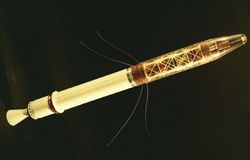
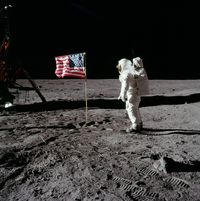



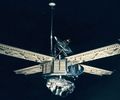
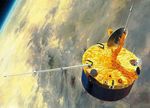

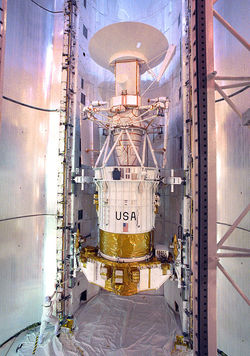
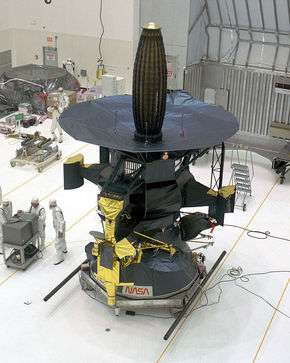

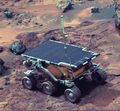
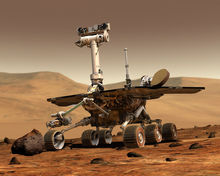




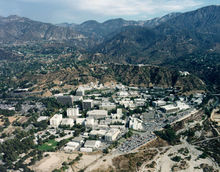
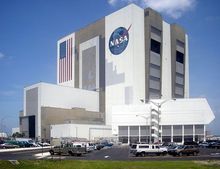
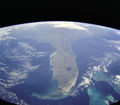
No comments:
Post a Comment